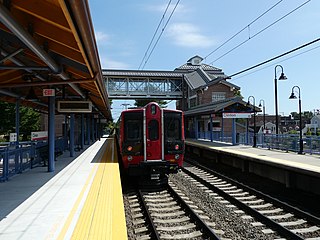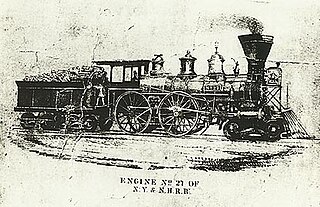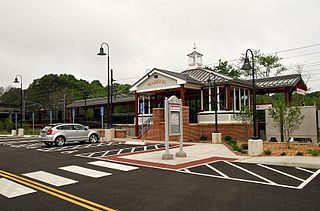
Shore Line East (SLE) is a commuter rail service which operates along the Northeast Corridor through southern Connecticut, United States. The rail service is a fully owned subsidiary of the Connecticut Department of Transportation (CTDOT) and is operated under the CT Rail brand. SLE provides service seven days a week along the Northeast Corridor between New London and New Haven; limited through service west of New Haven to Bridgeport and Stamford has been suspended since 2020. Cross-platform transfers to Metro-North Railroad New Haven Line trains are available at New Haven for service to southwestern Connecticut and New York City. Pre-COVID, around 2,200 riders used the service on weekdays.

The Providence and Worcester Railroad is a Class II railroad operating 612 miles (985 km) of tracks in Rhode Island, Massachusetts, and Connecticut, as well as New York via trackage rights. The company was founded in 1844 to build a railroad between Providence, Rhode Island, and Worcester, Massachusetts, and ran its first trains in 1847. A successful railroad, the P&W subsequently expanded with a branch to East Providence, Rhode Island, and for a time leased two small Massachusetts railroads. Originally operating on a single track, its busy mainline was double-tracked beginning in 1853, following a fatal collision that year in Valley Falls, Rhode Island.

The Boston and Providence Railroad was a railroad company in the states of Massachusetts and Rhode Island which connected its namesake cities. It opened in two sections in 1834 and 1835 - one of the first rail lines in the United States - with a more direct route into Providence built in 1847. Branches were built to Dedham in 1834, Stoughton in 1845, and North Attleboro in 1871. It was acquired by the Old Colony Railroad in 1888, which in turn was leased by the New Haven Railroad in 1893. The line became the New Haven's primary mainline to Boston; it was realigned in Boston in 1899 during the construction of South Station, and in Pawtucket and Central Falls in 1916 for grade crossing elimination.

The New York and New Haven Railroad (NY&NH) was a railroad connecting New York City to New Haven, Connecticut, along the shore of Long Island Sound. It opened in 1849, and in 1872 it merged with the Hartford & New Haven Railroad to form the New York, New Haven & Hartford Railroad. The line is now the Metro-North Railroad New Haven Line and part of Amtrak's Northeast Corridor.

The New York, Providence and Boston Railroad, normally called the Stonington Line, was a major part of the New York, New Haven and Hartford Railroad between New London, Connecticut and Providence, Rhode Island. It is now part of Amtrak's high-speed Northeast Corridor.

The Harlem River and Port Chester Railroad (HR&PC) was chartered in 1866 as a branch line railroad between New York City and Port Chester, New York. The line opened in 1873 as part of the New York, New Haven and Hartford Railroad and served in various capacities until 1971. The HR&PC is now part of the Hell Gate Line section of Amtrak's high-speed Northeast Corridor.

The New Haven–Springfield Line is a railroad line owned by Amtrak from New Haven, Connecticut, north to Springfield, Massachusetts. As a branch of the Northeast Corridor just north of New Haven State Street station, it is served by approximately seven daily Northeast Regional round trips, some continuing from New Haven to Washington, D.C., along the Corridor and others terminating at New Haven as shuttles. On weekends, there is one train daily to Roanoke, Virginia. It is also served by the daily Vermonter, which starts in Washington, D.C. and continues north from Springfield, finally terminating in St. Albans, Vermont. The line is part of the Inland Route connecting Boston and New York via Hartford, Springfield, and Worcester, in contrast to the "Shore Line" along the Connecticut Shore and through Rhode Island.

Interstate 95 (I-95) is the main north–south Interstate Highway on the East Coast of the United States, running in a general east–west compass direction for 111.57 miles (179.55 km) in Connecticut, from the New York state line to the Rhode Island state line. I-95 from Greenwich to East Lyme is part of the Connecticut Turnpike, during which it passes through the major cities of Stamford, Bridgeport, and New Haven. After leaving the turnpike in East Lyme, I-95 is known as the Jewish War Veterans Memorial Highway and passes through New London, Groton, and Mystic, before exiting the state through North Stonington at the Rhode Island border.
Coastal Connecticut, often called the Connecticut Shore or the Connecticut Shoreline, comprises all of Connecticut's southern border along Long Island Sound, from Greenwich in the west to Stonington in the east, as well as the tidal portions of the Housatonic River, Quinnipiac River, Connecticut River, and Thames River. It includes the southern sections of the state's Fairfield, New Haven, Middlesex and New London counties.

New London Union Station is a railroad station on the Northeast Corridor located in downtown New London, Connecticut, United States. Union Station is a station stop for most Amtrak Northeast Regional trains and all CTrail Shore Line East commuter rail trains, making it the primary railroad station in southeastern Connecticut. It serves as the centerpiece of the Regional Intermodal Transit Center, with connections to local and intercity buses as well as ferries to Long Island and Fishers Island, New York, and Block Island, Rhode Island. The station has one side platform and one island platform serving the two-track Northeast Corridor; the latter platform also serves a siding track that connects to the New England Central Railroad mainline.

U.S. Route 1 in the U.S. state of Connecticut is a major east–west United States Highway along Long Island Sound. It has been replaced by Interstate 95 as a through route, which it closely parallels, and now primarily serves as a local business route. Despite its largely east–west orientation, it is part of a north–south route, and is mostly signed north–south.

Clinton station is a regional rail station served by the CTrail Shore Line East service located near downtown Clinton, Connecticut. The station has two side platforms connected by a footbridge. Clinton is a commuter-only station; Amtrak's Acela Express and Northeast Regional services run through the station without stopping.

Madison is a passenger rail station along CTrail's Shore Line East commuter rail line, which runs on the Northeast Corridor between New Haven and New London. Madison station consists of a mid-sized parking lot and one high-level side platform on the southbound side of the tracks.

Niantic River Bridge, also known as Amtrak Bascule Bridge No. 116.74, is a railroad bridge carrying Amtrak's Northeast Corridor line across the Niantic River between East Lyme and Waterford, Connecticut. It is a drawbridge with a bascule-type draw span. A new bridge was constructed in 2012 to replace the former span built in 1907. It opened on September 8, 2012. Related construction work finished in June 2013.
The Clamdigger was a daily passenger train which ran along the Northeast Corridor during the 1970s. The train had two iterations: from 1898 to 1972 it was a local commuter service under the New Haven Railroad, Penn Central, and Amtrak between New London and New Haven, while from 1976 to 1978 it was a long-distance commuter service operated by Amtrak from Providence to New Haven. In 1978, it was canceled and replaced with the Beacon Hill.
The Shore Line Electric Railway was a trolley line along the southern coastline of Connecticut, running between New Haven and Old Saybrook with additional branches to Chester and Stony Creek. Unlike most trolley lines in New England, the Shore Line Electric was a true interurban, running large railway-style cars largely on a private right-of-way rather than on public streets. Though its main line was in operation for only 15 nonconsecutive years, the Shore Line Electric briefly acquired a substantial network of trolley lines stretching across eastern Connecticut, including the Norwich and Westerly Railway, the Groton and Stonington Street Railway, and several lines of the Connecticut Company. Most of the trolley line no longer is extant, however, the Shore Line Electric Railway Power House still stands along the mouth of the Connecticut River in Old Saybrook.

Groton was one of the shortest-lived Amtrak passenger rail stations, in service from January to April 1978 during the last incarnation of Amtrak's Clamdigger service. Previous stations at several locations in Groton saw both local and long-distance service from 1852 until the mid-20th century.

The Mystic River Railroad Bridge is a railroad bridge carrying Amtrak's Northeast Corridor over the Mystic River in Mystic, Connecticut, between the towns of Groton and Stonington.

Niantic was a train station on the Northeast Corridor located in the Niantic village of East Lyme, Connecticut. Opened in the 1850s, it was rebuilt in 1899 and again in 1954 by the New Haven Railroad. It closed in 1972, then reopened from 1978 to 1981 for use by the Amtrak Beacon Hill. A new station has since been proposed to be built in Niantic to serve the Shore Line East commuter rail service.



















